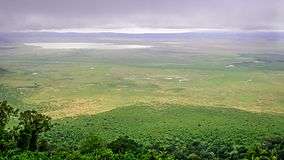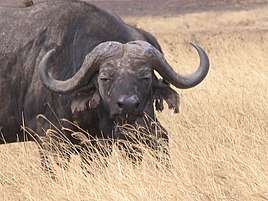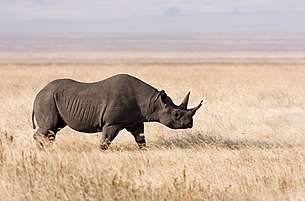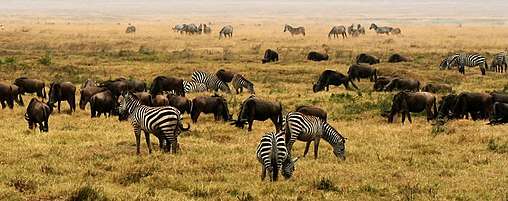Ngorongoro Conservation Area
The Ngorongoro Conservation Area (UK: /(ə)ŋˌɡɔːrəŋˈɡɔːroʊ/,[3] US: /ɛŋˌɡɔːroʊŋˈɡɔːroʊ, əŋˌɡoʊrɔːŋˈɡoʊroʊ/[4][5]) is a protected area and a World Heritage Site located 180 km (110 mi) west of Arusha in the Crater Highlands area of Tanzania. The area is named after Ngorongoro Crater (caldera), a large volcanic caldera within the area. The conservation area is administered by the Ngorongoro Conservation Area Authority, an arm of the Tanzanian government, and its boundaries follow the boundary of the Ngorongoro Division of the Arusha Region.
| Ngorongoro Conservation Area | |
|---|---|
 View of the crater | |
 | |
| Location | Arusha Region, Tanzania |
| Coordinates | 03°12′36″S 35°27′36″E |
| Area | 8,292 km2 (3,202 sq mi)[1] |
| Established | 1959 |
| Visitors | Over 500,000 per year[2] |
| Governing body | Ngorongoro Conservation Area Authority |
| Type | Natural |
| Criteria | (iv)(vii)(viii)(ix)(x) |
| Designated | 1979 (3rd session) |
| Reference no. | 39 |
| State Party | Tanzania |
| Region | Africa |
| Endangered | 1984–1989 |
The 2009 Ngorongoro Wildlife Conservation Act placed new restrictions on human settlement and subsistence farming in the Crater, displacing Maasai pastoralists, most of whom had been relocated to Ngorongoro from their ancestral lands to the north when the British colonial government established Serengeti National Park in 1959. [6][7]
History and geography
The name of the crater has an onomatopoeic origin; it was named by the Maasai pastoralists after the sound produced by the cowbell (ngoro ngoro). Based on fossil evidence found at the Olduvai Gorge, various hominid species have occupied the area for 3 million years.
Hunter-gatherers were replaced by pastoralists a few thousand years ago. The Mbulu[8] came to the area about 2,000 years ago and were joined by the Datooga around the year 1700. Both groups were driven from the area by the Maasai in the 1800s.[9][10]
No Europeans are known to have set foot in the Ngorongoro Crater until 1892, when it was visited by Oscar Baumann. Two German brothers (Adolph and Friedrich Siedentopf) farmed in the crater until the outbreak of World War I, after leasing the land from the administration of German East Africa. The brothers regularly organized shooting parties to entertain their German friends. They also attempted to drive the wildebeest herds out of the crater.[1][9][11]
In 1921, the first game preservation ordinance was passed, which restricted hunting to permit holders throughout Tanzania. In 1928, hunting was prohibited on all land within the crater rim, except the former Siedentopf farms. The National Park Ordinance of 1948 (implemented in 1951) created the Serengeti National Park (SNP). This, however, caused problems with the Maasai and other tribes, resulting in the Ngorongoro Conservation Area Ordinance (1959) that separated the conservation area from the national park. Maasai pastoralists living in Serengeti National Park were systematically relocated to Ngorongoro, increasing the population of Maasai and livestock living in the Crater.[12][7]:48 The Ngorongoro Conservation Area Authority was established by the Game Park Laws (miscellaneous amendments) Act, 1976 and owns the majority of Ngorongoro Conservation Area land, including the Crater. The area became a UNESCO World Heritage Site in 1979.[13] The Wildlife Conservation Act of 2009 further restricted human use of Ngorongoro Crater and created a legal framework to politically disenfranchise and forcibly displace traditional pastoralists.[7]:57–59 The restriction on land use generates tension between the local Maasai communities and conservation authorities. Currently, the International Union for Conservation of Nature (IUCN) is seeking solutions to ease conflict and improve collaborative efforts towards conservation with the locals.[14]
Land in the conservation area is multi-use and unique because it is the only conservation area in Tanzania that protects wildlife while allowing human habitation. Land use is controlled to prevent negative effects on the wildlife population. For example, cultivation is prohibited at all but subsistence levels.
The area is part of the Serengeti ecosystem and, to the northwest, adjoins the SNP and is contiguous with the southern Serengeti plains. These plains also extend to the north into the unprotected Loliondo division and are kept open to wildlife through transhumance pastoralism practiced by the Maasai. The south and west of the area are volcanic highlands, including the famous Ngorongoro Crater and the lesser known Empakaa Crateri. The southern and eastern boundaries are approximately defined by the rim of the East African Rift wall, which also prevents animal migration in these directions.
Geology
The Pliocene Ngorongoro Volcanic complex consists of 8 extinct shield volcanoes within the Eyasi Half-graben, the eastern boundary marked by the Gregory Rift Western Escarpment. The Lake Eyasi escarpment bounds the half-graben on the southwest. Within the complex, 5 volcanoes are dome-shaped cones, while 3 have calderas. Ngorongoro Volcano (2.5-1.9 Ma) is primarily basaltic trachyandesite. The caldera is fed by the Munge and Oljoro Nyuki Rivers, while the Ngoitokitok hot springs feed into the Goringop swamp. Lake Magadi is a shallow (1.7 m) alkaline lake. Other volcanoes within the complex include Olmoti (2.01-1.79 Ma), Empakaai, Loolmalasin, Sadiman (3.7 Ma), Lemagrut, and Oldeani. The northwest portion of the conservation area consists of the Serengeti Plains, the Salei Plains, the Oldupai Gorge, and the Gol Mountains inselbergs. These inselbergs are part of the Mozambique Belt quartzite and mica schist about (800-500 Ma) in age.[15]
Ngorongoro Crater
.jpg)
The main feature of the Ngorongoro Conservation Authority is the Ngorongoro Crater, the world's largest inactive, intact and unfilled volcanic caldera.[16] The crater, which formed when a large volcano exploded and collapsed on itself two to three million years ago, is 610 metres (2,000 feet) deep and its floor covers 260 square kilometres (100 square miles).[11][17] Estimates of the height of the original volcano range from 4,500 to 5,800 metres (14,800 to 19,000 feet) high.[17] The crater floor is 1,800 metres (5,900 feet) above sea level.[1] The crater was voted by Seven Natural Wonders [18] as one of the Seven Natural Wonders of Africa in Arusha, Tanzania in February 2013.[19] The Ngorongoro volcano was active from about 2.45 to 2 million years ago.[11]
The volcanic eruptions like that of Ngorongoro, which resulted in the formation of Ngorongoro Crater in Tanzania, were very common. Similar collapses occurred in the case of Olmoti and Empakaai, but they were much smaller in magnitude and impact.
Out of the two recent volcanoes to the northeast of the Empakaai caldera, Kerimasi and Ol Doinyo Lengai, Doinyo Lengai is still active and had major eruptions in 2007 and 2008. Smaller ash eruptions and lava flows continue to slowly fill the current crater. Its name is Maasai language for ‘Mountain of God’.[16]
.jpg)
The Munge Stream drains Olmoti Crater to the north, and is the main water source draining into the seasonal salt lake in the center of the crater. This lake is known by two names: Makat as the Maasai called it, meaning salt; and Magadi.[20] The Lerai Stream drains the humid forests to the south of the Crater, and it feeds the Lerai Forest on the crater floor - when there is enough rain, the Lerai drains into Lake Magadi as well. Extraction of water by lodges and Ngorongoro Conservation Area headquarters reduces the amount of water entering Lerai by around 25%.[21]
The other major water source in the crater is the Ngoitokitok Spring, near the eastern crater wall. There is a picnic site here open to tourists and a huge swamp fed by the spring, and the area is inhabited by hippopotamus, elephants, lions and many others. Many other small springs can be found around the crater's floor, and these are important water supplies for the animals and local Maasai, especially during times of drought.[22] Masai were previously permitted to graze their cattle within the crater, but as of 2015 were restricted from doing so. [12]
Oldupai or Olduvai Gorge
The Ngorongoro Conservation Area also protects Oldupai or Olduvai Gorges , situated in the plains area. It is considered to be the seat of humanity after the discovery of the earliest known specimens of the human genus, Homo habilis as well as early hominidae, such as Paranthropus boisei.
The Olduvai Gorge is a steep-sided ravine in the Great Rift Valley, which stretches along eastern Africa. Olduvai is in the eastern Serengeti Plains in northern Tanzania and is about 50 kilometres (31 mi) long. It lies in the rain shadow of the Ngorongoro highlands and is the driest part of the region.[23] The gorge is named after 'Oldupaai', the Maasai word for the wild sisal plant, Sansevieria ehrenbergii.
It is one of the most important prehistoric sites in the world and research there has been instrumental in furthering understanding of early human evolution. Excavation work there was pioneered by Mary and Louis Leakey in the 1950s and is continued today by their family. Some believe that millions of years ago, the site was that of a large lake, the shores of which were covered with successive deposits of volcanic ash. Around 500,000 years ago seismic activity diverted a nearby stream which began to cut down into the sediments, revealing seven main layers in the walls of the gorge.
Wildlife
 African buffalo in Ngorongoro Conservation Area
African buffalo in Ngorongoro Conservation Area.jpg) Black Rhinoceros
Black Rhinoceros.jpg) Lion cubs
Lion cubs.jpg) Wildebeest
Wildebeest.jpg) Hippopotamus
Hippopotamus.jpg) Eland
Eland.jpg) Blue monkey
Blue monkey Hook-lipped (black) rhinoceros in the crater
Hook-lipped (black) rhinoceros in the crater Wildebeest and zebra in a herd
Wildebeest and zebra in a herd.jpg) Silvery-cheeked hornbill
Silvery-cheeked hornbill.jpg) Grey crowned cranes
Grey crowned cranes.jpeg) Hyena
Hyena
Approximately 25,000 large animals, mostly ungulates, live in the crater.[24] Large mammals in the crater include the black rhinoceros (Diceros bicornis michaeli), the local population of which declined from about 108 in 1964-66 to between 11–14 in 1995, the African buffalo or Cape buffalo (Syncerus caffer), and the hippopotamus (Hippopotamus amphibius).[24] There also are many other ungulates: the blue wildebeest (Connochaetes taurinus) (7,000 estimated in 1994), Grant's zebra (Equus quagga boehmi) (4,000), the common eland (Taurotragus oryx), and Grant's (Nanger granti) and Thomson's gazelles (Eudorcas thomsonii) (3,000).[24] Waterbucks (Kobus ellipsiprymnus) occur mainly near Lerai Forest.[24]
Absent are giraffe, impala (Aepyceros melampus), topi (Damaliscus lunatus), oribi (Ourebia oribi), crocodile (Crocodylus niloticus).[1][16]
Cheetah (Acinonyx jubatus raineyi), East African wild dog (Lycaon pictus lupinus), and African leopard (Panthera pardus pardus) are rarely seen.[1][25] Spotted hyenas (Crocuta crocuta) have been the subject of a long-term research study in the Ngorongoro Conservation Area since 1996.
Although thought of as "a natural enclosure" for a very wide variety of wildlife, 20 percent or more of the wildebeest and half the zebra populations vacate the crater in the wet season, while Cape buffalo (Syncerus caffer) stay; their highest numbers are during the rainy season.[16]
Since 1986, the crater's wildebeest population has fallen from 14,677 to 7,250 (2003-2005).[16] The numbers of eland and Thomson's gazelle also have declined while the buffalo population has increased greatly, probably due to the long prevention of fire which favors high-fibrous grasses over shorter, less fibrous types.[16][24]
Serval (Leptailurus serval) occurs widely in the crater.[24]
Lake Magadi, a large lake in the southwest of the crater, is often inhabited by thousands of mainly lesser flamingoes.[26]
The crater has one of the densest known population of lions,[27] numbering 62 in 2001.[24]
A side effect of the crater being a natural enclosure is that the lion population is significantly inbred. This is due to the very small amount of new bloodlines that enter the local gene pool, as very few migrating male lions enter the crater from the outside. Those who do enter the crater are often prevented from contributing to the gene pool by the crater's male lions, who expel any outside competitors.[1]
Long-term data imply that lions in the crater were struck by four deadly disease outbreaks between 1962 and 2002.[28] Drought in 1961 and rains throughout the 1962 dry season caused a massive build-up of blood-sucking stable flies (Stomoxys calcitrans) by May 1962. They drained blood and caused painful skin sores that became infected, causing lion numbers to crash from 75-100 to 12. The population recovered to around 100 by 1975 and remained stable until 1983, when a persistent decline began. Numbers have generally remained below 60 animals since 1993, reaching a low of 29 in 1998. In 2001, 34 percent of the lion population died between January and April from a combination of tick-borne disease and canine distemper.[29][16][30]
The lion population is also influenced to some extent by the takeover of prides by incoming males, which typically kill small cubs.[28] The biggest influence, however, appears to be disease, particularly canine distemper.[31]
Outside Ngorongoro Crater
The Ngorongoro Conservation Area has a healthy resident population of most species of wildlife. The Ndutu Lake area to in the west of the conservation area has particularly strong cheetah and lion populations. Common in the area are hartebeest (Alcelaphus buselaphus), spotted hyena (Crocuta crocuta), and jackals.[24] The population of African wild dog may have declined recently.[24] Servals occur widely on the plains to the west of the Ngorongoro Crater.[24]
The annual ungulate migration passes through the Ngorongoro Conservation Area, with 1.7 million wildebeest, 260,000 zebra, and 470,000 gazelles moving south into the area in December and moving north in June. This movement changes seasonally with the rains, but the migration traverses almost the entire plains in search of food.[24]
References
- "The historical ecology of the large mammal populations of Ngorongoro Crater, Tanzania, east Africa", Mammal Review, authored by Louise Oates and Paul A. Rees, 2012
- "Dar registers "three wonders"". Daily News (Tanzania). 20 August 2012. Archived from the original on 22 September 2012. Retrieved 28 January 2013.
- "Ngorongoro". Lexico UK Dictionary. Oxford University Press. Retrieved 2 August 2019.
- "Ngorongoro Crater". The American Heritage Dictionary of the English Language (5th ed.). Boston: Houghton Mifflin Harcourt. Retrieved 2 August 2019.
- "Ngorongoro Crater". Merriam-Webster Dictionary. Retrieved 2 August 2019.
- 'Tourism is a curse to us', Guardian, 6 September 2009
- Laltaika, Elifuraha (2013). "Pastoralists' Right to Land and Natural Resources in Tanzania" (PDF). Oregon Review of International Law. 15 (1): 43–62. ISSN 1543-9860. Retrieved 12 June 2017.
- "Mbulu", Information about northern Tanzania: a personal scrapbook of "cuttings" from published sources
- Northern Tanzania: The Bradt Safari Guide with Kilimanjaro and Zanzibar, authored by Phillip Briggs, 2006, pages 197, 198 ISBN 1-84162-146-3
- Excerpt from Ngorongoro Conservation Area, authored by Jeannette Hanby & David Bygott, Information about northern Tanzania: a personal scrapbook of "cuttings" from published sources
- Africa's Great Rift Valley, authored by Nigel Pavitt, Harry N. Abrams, Inc., New York, 2001, pages 135-139 ISBN 0-8109-0602-3
- Robert M. Poole. "Heartbreak on the Serengeti". National Geographic. p. 4. Archived from the original on 29 June 2012. Retrieved 21 February 2008.
- Homewood, K. M.; Rodgers, W. A. (2004). Maasailand Ecology: Pastoralist Development and Wildlife Conservation in Ngorongoro, Tanzania. Cambridge University Press. ISBN 9780521607490.
- Hodgetts, Timothy; Lewis, Melissa; Bauer, Hans; Burnham, Dawn; Dickman, Amy; Macdonald, Ewan; Macdonald, David; Trouwborst, Arie (2 June 2018). "Improving the role of global conservation treaties in addressing contemporary threats to lions". Biodiversity and Conservation. 27 (10): 2747–2765. doi:10.1007/s10531-018-1567-1. ISSN 0960-3115. PMC 6435094. PMID 30996533.
- Scoon, R. (2018). Geology of National Parks of Central/ Southern Kenya and Northern Tanzania: Geotourism of the Gregory Rift Valley, Active Volcanism and Regional Plateaus. Springer. pp. 103–114. ISBN 9783319737843.
- Estesa, R. D.; Atwood, J. L.; Estes, A. B. (2006). "Downward trends in Ngorongoro Crater ungulate populations 1986–2005: Conservation concerns and the need for ecological research" (PDF). Biological Conservation: 107. doi:10.1016/j.biocon.2006.02.009. Archived from the original (PDF) on 7 September 2016. Retrieved 23 October 2007.
- Sinclair, A. R. E.; Packer, C.; Mduma, S. A. R.; Fryxell, J. M. (2009). Serengeti III: Human Impacts on Ecosystem Dynamics. University of Chicago Press. ISBN 9780226760353. Retrieved 12 June 2018.
- "About – Seven Natural Wonders". sevennaturalwonders.org. Retrieved 12 June 2018.
- "Seven Natural Wonders of Africa – Seven Natural Wonders". sevennaturalwonders.org. Archived from the original on 21 December 2015. Retrieved 12 June 2018.
- Deocampo, D.M. (2004). "Hydrogeochemistry in the Ngorongoro Crater, Tanzania, and implications for land use in a World Heritage Site". Applied Geochemistry. 19 (5): 755−767. Bibcode:2004ApGC...19..755D. doi:10.1016/j.apgeochem.2003.10.006.
- "Management of Black Rhino in the Ngorongoro Crater" (PDF). African Wildlife Foundation. 2003. Retrieved 21 February 2008.
- Estesa, R. D.; Atwood, J. L. & Estes, A. B. (2006). "Downward trends in Ngorongoro Crater ungulate populations 1986–2005: Conservation concerns and the need for ecological research" (PDF). Biological Conservation. 131 (1): 116–117. doi:10.1016/j.biocon.2006.02.009.
- Pavitt, N. (2001). Africa's Great Rift Valley. New York: Harry N. Abrams, Incorporated. ISBN 0-8109-0602-3.
- "Ngorongoro Conservation Area". United Nations Educational, Scientific and Cultural Organization – World Heritage Centre. Retrieved 3 June 2014.
In summer enormous numbers of Serengeti migrants pass through the plains of the reserve, including 1.7 million wildebeest, 260,000 zebra and 470,000 gazelle.
- Kissui, B. M.; Mosser, A.; Packer, C. (2010). "Persistence and local extinction of lion prides in the Ngorongoro Crater, Tanzania". Population Ecology. 52: 103–111. doi:10.1007/s10144-009-0176-y.
- Education, Jacana; Watson, Dave (12 August 2008). Ngorongoro Visitor Map Guide. Jacana Media. ISBN 9781770091733. Retrieved 12 June 2018 – via Google Books.
- "The Crater Lions", Nature, United States Public Broadcasting System
- na. ProQuest. ISBN 9780549678335. Retrieved 12 June 2018 – via Google Books.
- "Stomoxys", Information about northern Tanzania: a personal scrapbook of "cuttings" from published sources
- na. ProQuest. ISBN 9780549678335. Retrieved 12 June 2018 – via Google Books.
- na. ProQuest. ISBN 9780549678335. Retrieved 12 June 2018 – via Google Books.
Further reading
- Ngorongoro Conservation Area at the UNEP World Conservation Monitoring Centre
- Deocampo, D.M. (2004). "Hydrogeochemistry in the Ngorongoro Crater, Tanzania, and implications for land use in a World Heritage Site". Applied Geochemistry. 19: 755–767. Bibcode:2004ApGC...19..755D. doi:10.1016/j.apgeochem.2003.10.006.
- Deocampo, D.M. (2005). "Evaporative evolution of surface waters and the role of aqueous CO2 in magnesium silicate precipitation: Lake Eyasi and Ngorongoro Crater, northern Tanzania". South African Journal of Geology. 108: 493–504. doi:10.2113/108.4.493.
External links
| Wikimedia Commons has media related to Ngorongoro. |
- Ngorongoro Conservation Area Authority
- Ngorongoro crater facts
- Tanzania Tourist Bureau
- "UNEP-WCMC World Heritage Site Datasheet" (PDF). Archived from the original (PDF) on 1 September 2012. Retrieved 1 September 2012.
- UNESCO World Heritage Site Datasheet


